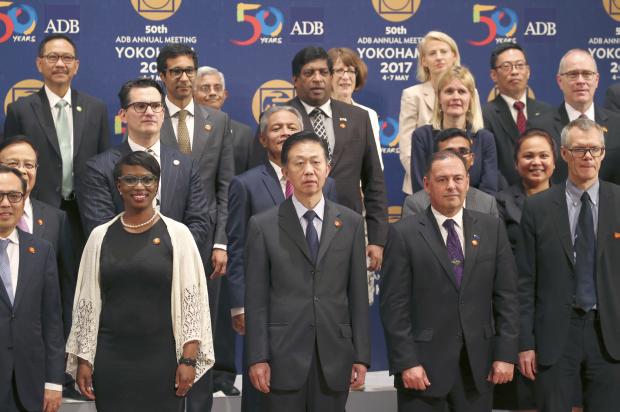Asian Development Bank takes stock as US policy shifts

Chinese Finance Minister Xiao Jie (front row center) and members of the Asian Development Bank board of governors pose together during a group photo session at the ADB annual meeting in Yokohama, Saturday, May 6, 2017. The bank is marking its 50th year at an annual meeting in the port city of Yokohama near Tokyo. (Photo by KOJI SASAHARA / AP)
YOKOHAMA, Japan — Accelerating growth in Southeast and South Asia can help make up for slowing momentum in China but it requires smart investments in infrastructure and technology, the president of the Asian Development Bank said Saturday as the regional lender started a meeting of its board of governors.
ADB President Takehiko Nakao and other leaders of the regional lender said investments should concentrate on high-quality projects and technology should be made available to all as countries stretches to make up for shortfalls in needed spending, they said.
Nakao said he was optimistic about the outlook for Asia, which contributes about half of world economic growth. Overall growth is forecast at 5.7 percent in 2017 and economies in India, Bangladesh, Indonesia, Myanmar, the Philippines and Vietnam are gaining momentum.
The unstated backdrop to the meeting is Japan’s continued strong role in the ADB at a time when the administration of US President Donald Trump has adopted an “America first” stance and China is pushing ahead with its own infrastructure initiatives.
Opening the meeting in the port city of Yokohama, Finance Minister Taro Aso said Japan, the biggest donor to the ADB, would contribute $40 million to a fund promote use of high technology.
Aso said that as the Manila, Philippines-based ADB marks its 50th year it should adopt a “strong strategy” to ensure it remains a “highly relevant” institution at a time when needs for investment in infrastructure such as power generation, sanitation, roads and ports are growing in both “quantity and quality.”
The ADB estimates more than $26 trillion is needed for ports, power, water and other infrastructure in the region by 2030, or over $1.7 trillion a year. The current level of spending is below $900 billion
Aso said the regional lender should generally prioritize poorer countries in allocating its financing while helping “upper middle income” countries with expertise in such areas as environmental protection.
Aso welcomed moves to reform purchasing procedures to “put more emphasis on quality.”
“I encourage the bank to continue to move in this direction,” he said.
The policy shift under Trump is raising questions over the strength of the US commitment to multilateral organizations like the ADB, raising questions about how to increase financing and make it as effective as possible.
Nakao, the ADB president, said the lender was working to find ways to streamline its operations and deepen collaboration with local governments and the private sector. Co-financing with other banks, including the China-backed Asia Infrastructure Investment Bank, and with the private sector has become an increasingly important source of support, involving $13.9 billion of the total $31.7 billion in funds allocated last year by the bank.